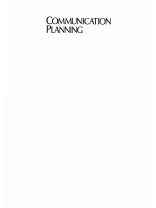The nature of the communicator′s job has shifted dramatically in the last decade. While communicators still prepare speeches, press releases, and articles for corporate magazines, they are now being asked to perform managerial duties, including planning, consulting with stakeholders, and advising CEOs and vice presidents.
With these additional responsibilities as a focus, Communication Planning takes a comprehensive approach to examining the role of integrated planning in modern organizations. Author Sherry Ferguson divides the book into four parts: 1) establishing strategic planning cultures, 2) writing different types of communication plans, 3) theoretical foundations of communication planning, and 4) strategic approach to planning for issues management.
This book breaks new ground in the study of organizational communication and public relations and contains essential information for consultants, practitioners, and students.
Spis treści
Introduction
PART ONE: STRATEGIC PLANNING CULTURES
The Making of Strategic Planning Cultures
The Role of Integrated Communication Planning
PART TWO: INTEGRATED PLANNING PROCESSES
Writing the Strategic Communication Plan (Multiyear or Annual)
Writing the Multiyear or Annual Operational and Work Plans
Writing the Communication Support Plan
Planning for Special Events, Campaigns and Issues
Writing the Contingency Plan for Crises
COMMUNICATION THEORIES: THE FOUNDATION FOR PLANNING
Understanding the Psychology of Audiences
Beliefs, Attitudes, Values and Needs
The Bases of Source Credibility
Message Design
Perception, Cognition and Information Acquisition
Message Design
Theories of Persuasion
Choosing the Channel
Lessons Learned
PART FOUR: STRATEGIC PROCESSES
Strategic Approaches to Planning for Issues Management
Planning Cooperative Strategies
Partnering, Consulting and Negotiating












